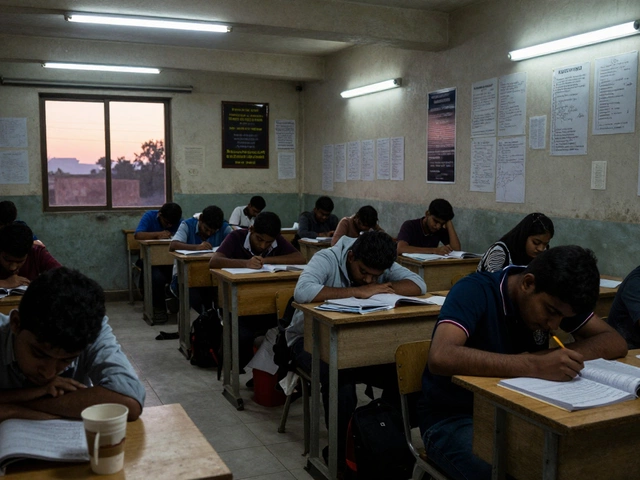You got a 10,000 rank in JEE Advanced, and now your mind’s racing. Dreaming of the IIT tag, but not sure which options are really on the table? You’re not alone. Every year, thousands are stuck in the same boat—flipping through closing ranks, desperately hoping their preferred campus might just swing open its gates. But what’s fact and what’s fantasy when it comes to the IIT cut-offs for this range?
Let’s bust one quick myth: a 10,000 rank might not land you in the obvious “holy trinity”—IIT Bombay, IIT Delhi, or IIT Madras—for the most wanted branches. But don’t write yourself off. The story doesn’t end with the top three or even the top seven. IITs have expanded, new branches keep opening, and even less-hyped campuses now offer courses with top-notch faculty, resources, and wild placement records. I’ve seen students with similar ranks thrive, picking the right combo of campus and course and then using every bit of IIT juice for their careers. But where do you start? Let’s deep dive—and yeah, I don’t mean a soul-crushing stats dump, but real, up-to-date advice that actually helps make a choice with your head, not just your heart or family WhatsApp group.
Understanding the 10,000 Rank: What It Means for Your IIT Options
The first thing to get clear about is what a 10,000 All India Rank in JEE Advanced actually signals in the mad race for an IIT seat. This rank typically places you in the latter half of the student pool qualifying for counseling. It isn’t the front row, but you still have a shot at several hot options. For 2024, over 43,000 candidates cleared the cutoff, and almost 18,000 IIT seats were up for grabs. The numbers for 2025 haven’t dramatically shifted—expect a similar trend because most seat increments at IITs are slow and depend on government approvals and new campus launches.
Here’s where things get practical: old IITs—like Bombay, Delhi, Kanpur, Madras, Kharagpur, Guwahati, and Roorkee—usually fill most branches (especially CSE, ECE, and Mechanical) by the first 5,000 to 8,500 ranks. Not impossible, but pretty rare for a 10k rank to crack these branches unless you fall into a reserved category. Dual-degree options widen up a bit, but for General category aspirants, it’s the newer IITs or the older ones’ less-crowded branches and interdisciplinary courses that stand out.
Let’s talk about the expansion of IITs. Since 2008, several “second generation” IITs—like IIT Indore, IIT Mandi, IIT Ropar, IIT Bhubaneswar, IIT Jodhpur, IIT Patna, IIT Gandhinagar, and the latest crop like IIT Palakkad, Tirupati, Bhilai, Goa, and Jammu—have come up. Every year, closing ranks for these campuses tend to be significantly higher for most branches. It’s no secret that even Computer Science at IIT Goa or Chemical Engineering at IIT Bhubaneswar run much higher closing numbers compared to the old guard over in Mumbai or Delhi. And placement numbers? They’re catching up. A 2024 report saw average salaries at some new IITs already crossing ₹18-20 lakhs for top branches. Compare that to older NITs or IIITs, and you’ll see why these choices aren’t a “step down.”
Now, branch selection plays a massive role. Chasing Computer Science everywhere rarely works out at this rank. But shifting your focus to branches like Chemical, Metallurgy, Mining, Engineering Physics, and even newer interdisciplinary courses like Data Science, Artificial Intelligence, or Environmental Engineering? Way more realistic—and surprisingly, some of these specializations are exploding in popularity with recruiters lately.
Still, every year throws a few curveballs—trend reversals, unexpected cut-offs, and brilliant stories from folks who trusted the process. Want real numbers? Here’s a quick peek at 2024 closing ranks for various IITs (General category, last round):
| IIT | Branch | Closing Rank (General) |
|---|---|---|
| IIT Bhubaneswar | Metallurgical Engg. | 10343 |
| IIT Jammu | Civil Engg. | 10983 |
| IIT Patna | Mechanical Engg. | 9574 |
| IIT Jodhpur | Bioscience & Bioengineering | 10188 |
| IIT Goa | Electrical Engg. | 9684 |
| IIT Dharwad | Data Science & AI | 9805 |
| IIT Bhilai | Mechanical Engg. | 10452 |
| IIT Palakkad | Civil Engg. | 11340 |
| IIT Mandi | Engineering Physics | 10900 |
You don’t have to memorize these numbers—your eyes probably glazed over halfway. The big takeaway? Many new IITs take in students well beyond that 10,000 mark for solid branches, and the options get even broader if you consider category-based reservations.
Honestly, students who can spot rising fields and have an open mind about moving cities, adapting to fresh campuses, or picking niche branches are the ones who milk IIT life (and placements) for all it’s worth. It’s a lot less about the campus than you think—and a lot more about getting your foot in, showing up, and building networks once you’re there. Don’t just weigh “famous city” versus “tier-2 campus”—old notions about placement gaps are shrinking each year.

Your Exact IIT Choices: Campus and Branch Combinations That Work
Alright, so you’re holding a 10,000 rank and probably calculating your odds obsessively. Which IITs and branches could you genuinely bag? Here’s where you stop the wild guessing and use the hard data mixed with 2025 trends. The trick: focus on less popular (but up-and-coming) branches, newer IITs, or dual-degree options. Let me break it down honestly.
- IIT Bhubaneswar: Offers Metallurgy, Environmental, Ocean, and even Civil at higher closing ranks. Placement averages are rising fast here, especially for interdisciplinary branches.
- IIT Jammu: Civil and Mechanical are very much within reach. The campus is still ramping up in terms of infrastructure, but has seen tie-ups with public sector companies.
- IIT Dharwad: Data Science & Artificial Intelligence appeared with a closing rank close to 9800. This branch is new but white-hot in industry, so worth a nudge if you can adapt.
- IIT Goa and IIT Palakkad: Solid picks. Physics, Civil, and even Electrical sometimes take in ranks around 10,000, especially in later rounds.
- IIT Mandi: Known for an intense academic setup, with Engineering Physics and Materials Science open for higher ranks. Students often pivot to tech through research-oriented internships.
- IIT Patna, Jodhpur, Bhilai: Flexible in offering core branches at higher cut-offs. Another pro? Many tie-ups and research opportunities, especially for those interested in post-grad studies or government jobs afterward.
If you’re an OBC, SC, ST, or EWS candidate, your choices widen dramatically. For example, Computer Science at even older IITs drops its closing ranks by a large margin for reserved categories—sometimes by 5,000-7,000 spots. Don’t ignore this if you qualify; check the official JOSAA data.
Feeling adventurous? Dual-degree (B.Tech + M.Tech) and interdisciplinary courses hover at higher ranks because many want to keep options open for other counseling rounds. But here’s a tip: some of these dual-degree programs punch above their weight in terms of research funding and campus links to foreign universities.
If you’re still hesitating on taking a less ‘glamorous’ branch—like Metallurgical or Environmental—the landscape is shifting. Just check the startups and unicorns coming out of these divisions. India’s fastest-growing energy, climate tech, and data sectors aren’t recruiting only Computer Science grads these days. In fact, for someone with a foot in IIT’s extensive alumni network, opportunities blow up wide if you perform and hustle.
Sometimes students ask: "Should I take a lesser-known branch at an IIT, or go for CSE/ECE at a top NIT or IIIT?" There’s no fixed answer—but if you value the IIT label and the culture/interconnectivity of the alumni network, even a less hyped branch can mean better career springboards. Many companies shortlist straight from IIT’s central database, branch-blind for management and consulting roles. Want an example? A buddy of mine from IIT Patna’s Mechanical batch jumped to Google via off-campus recruitment—the right skills still beat branch stereotypes.
Here’s what works for maximizing your 10,000-rank journey:
- Keep branch preferences flexible. Famous CSE branches? Tough. Data, Maths, Bioengineering, or interdisciplinary fields? Not as cut-throat.
- Look at last year’s IIT admission cut-off charts, but keep a margin—closing ranks move +/- 400 places every year due to “trend chasers.”
- Prioritize campus culture, faculty quality, and research opportunities. A motivated prof can open more doors than a big city nameplate.
- Use JOSAA’s mock seat allocation to experiment—fill out LOTS of choices (all the way to the last counseling round if you want all possible shots). Don’t leave blanks you’ll regret.
- If you’re set on a core engineering job, dig into placement stats by branch—not just college average. Some branches have hidden gems.
There’s less need to chase just the “top seven” IITs. Newer IITs aren’t backup plans—they’re fast-evolving, with smaller batch sizes that sometimes get you more attention from faculty and recruiters. Plus, these campuses frequently tie up with European and US universities for semester exchanges. That’s not something even Max, my overexcited dog, could sniff out without some research!

Smart Counseling Moves and Life After a 10,000 Rank at IITs
This part is where most students slip up: filling out the counseling choices. Some just copy-paste their “dream list,” then are devastated when nothing clicks. Others under-fill because they fear ending up at an unpopular branch. So, what’s the right game plan?
Strategy #1: Fill the maximum number of choices on JOSAA—no ego, no pride. The seat allocation system literally rewards volume; you can always let go of a seat during rounds but it won’t pull in fresh options if you under-fill. You’ll thank yourself later—one overlooked branch might just be your ticket to campus and a killer peer group.
Strategy #2: Prioritize your wishlist. How do you do this? First, sort the courses that excite you: Data Science, Engineering Physics, Environmental, Mechanical, etc. Put these higher, even if in a new IIT. Then, fill in rest—interdisciplinary, dual-degree, or niche branches. Last, add every campus with any seat possible, just to stay in the running as rounds progress and people drop out for NITs, IIITs, or overseas options. You never know which seat will open up in the sixth round while thousands run behind trending colleges.
Strategy #3: Use mock counseling. Services like College Pravesh, JOSAA’s official mock rounds, and even Reddit threads (surprisingly reliable for last-minute cut-off changes) can help you tweak your preferences as real closing ranks emerge. Ignore pushy advice from relatives who graduated decades ago—what worked in 2009 won’t predict 2025 trends.
Strategy #4: Mental preparation and adaptability. Getting a lesser-known IIT or an unfamiliar branch is no life sentence. Alumni networks, cross-branch electives, research internships, and even minor programs allow you to rebrand yourself. Want to code? Pick up electives and side projects. Thinking higher studies? Interdisciplinary research is booming, and many grad school admissions in the US/Europe actually love diversity in undergraduate majors.
Don’t fixate on comparison. A 10,000 rank doesn’t define your trajectory. I know students who started in Environmental at IIT Palakkad, then went to Ivy League grad schools or switched careers entirely after discovering a wild talent for robotics or entrepreneurship.
Quick mental note—be realistic about location, too. Newer IITs might mean moving to a smaller city, and campus facilities can take another 2–3 years to reach the “old IIT” levels. But the flipside? More attention from faculty, closer-knit peer groups, and sometimes a lower cost of living. Delhi, Bombay, and Kharagpur are legendary—but Goa sunsets, Mandi’s mountain air, and Palakkad’s greenery aren’t exactly purgatory.
Here’s a short list to check off as you plot your way forward:
- Check closing ranks from last year for every branch and campus you’re considering.
- Shortlist 10–12 campuses/branches you’re genuinely open to, and fill them as high as possible on your JOSAA list.
- Include dual-degree, interdisciplinary, and research-centric branches. Sometimes these open hidden doors (like international research stints or startup incubators).
- Gear up mentally to make the most wherever you land—clubs, research projects, coding contests, cultural festivals—it’s all about using what’s on offer to pivot your future.
- Stay updated; cutoffs and trends change fast, and smart candidates read the room till the last counseling round.
The IIT badge packs serious career value, no matter if you enter through Mechanical at IIT Patna or Data Science at IIT Dharwad. When companies visit campuses, they look for problem-solvers, not just branch toppers. And if you ever chat with recruiters at Goldman Sachs, TCS, or emerging unicorns, you’ll see plenty of stories that start with, “I got in with a just-okay rank, but I made every bit count.”
So yeah—don’t obsess over a three-digit or four-digit rank. Find the right campus and branch, fill those choices, and be ready to make your own legend. After all, getting into IIT is just the handshake, not the finish line. Trust me, Max would agree if he understood counseling forms—when all the food bowls look the same, it’s what you do with what’s in front of you that decides your day.





